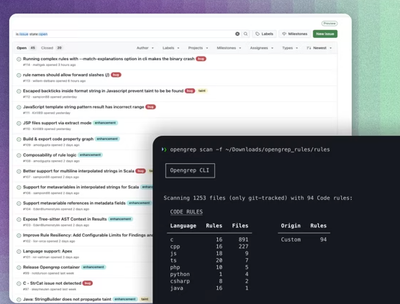
Research
Security News
Lazarus Strikes npm Again with New Wave of Malicious Packages
The Socket Research Team has discovered six new malicious npm packages linked to North Korea’s Lazarus Group, designed to steal credentials and deploy backdoors.
A tiny library to safely render compact HTML5 from Python expressions.
.. image:: https://github.com/niklasf/python-tinyhtml/workflows/Test/badge.svg :target: https://github.com/niklasf/python-tinyhtml/actions :alt: Test status
.. image:: https://badge.fury.io/py/tinyhtml.svg :target: https://pypi.python.org/pypi/tinyhtml :alt: PyPI package
This is the entire API. The following documentation is longer than the implementation.
.. code:: python
>>> from tinyhtml import html, h, frag, raw
The most important function is h(). Below you see how to render attributes,
normal elements, and void/self-closing elements.
.. code:: python
>>> html(lang="en")(
... h("head")(
... h("meta", charset="utf-8"),
... ),
... ).render()
'<!DOCTYPE html><html lang="en"><head><meta charset="utf-8"></head></html>'
Use frag() to pass around groups of elements.
.. code:: python
>>> frag(
... h("h1")("Lorem ipsum ..."),
... h("p")("... dolor sit amet."),
... )
raw('<h1>Lorem ipsum ...</h1><p>... dolor sit amet.</p>')
Of course all content and attributes are properly escaped. Use raw() as an
escape hatch to render unescaped HTML.
.. code:: python
>>> print(h("a", title="&<>\"'")("&<>\"'").render())
<a title="&<>"'">&<>"'</a>
>>> print(raw("<!-- 💥"))
<!-- 💥
::
pip install tinyhtml
Output is compact: Naturally produces no superfluous whitespace between elements.
Fragments provide _repr_html_() for Jupyter notebook integration and
__html__ for integration with other ecosystems (see
MarkupSafe <https://markupsafe.palletsprojects.com/en/stable/html/>_).
Fragments can include and render objects providing _repr_html_() and
__html__(). This means objects that already render as HTML in a
Jupyter notebook will be rendered by tinyhtml.
Includes mypy typings.
.. code:: python
>>> from tinyhtml import Frag
Write templates as functions.
.. code:: python
>>> def layout(title: str, body: Frag) -> Frag:
... return html()(
... h("head")(
... h("title")(title),
... ),
... h("body")(body)
... )
>>> layout("Hello world", frag(
... h("h1")("Hello world"),
... h("p")("Lorem ipsum dolor sit amet."),
... ))
raw('<!DOCTYPE html><html><head><title>Hello world</title></head><body><h1>Hello world</h1><p>Lorem ipsum dolor sit amet.</p></body></html>')
Use str, int, other fragments, None, or iterables of these as
child elements. (Note that rendering consumes the iterables, so fragments
using generators can be rendered only once.)
.. code:: python
>>> h("ul")(
... h("li")(n) for n in range(3)
... )
raw('<ul><li>0</li><li>1</li><li>2</li></ul>')
>>> h("ul")(
... h("li")("Foo") if False else None,
... h("li")("Bar"),
... )
raw('<ul><li>Bar</li></ul>')
Use str, int, None, iterables of these, bool, or dictionaries
with boolean values as attributes.
.. code:: python
>>> h("input", type="checkbox", checked=True, disabled=False)
raw('<input type="checkbox" checked>')
>>> h("body", klass=["a", "b"])()
raw('<body class="a b"></body>')
>>> h("body", klass={
... "a": True,
... "b": False,
... })()
raw('<body class="a"></body>')
Use klass instead of class, append a trailing underscore (for_),
or use underscores instead of dashes (http_equiv) for attribute names
that cannot be Python identifiers.
.. code:: python
>>> h("div", klass="container")()
raw('<div class="container"></div>')
>>> h("label", for_="name")("Name")
raw('<label for="name">Name</label>')
>>> h("meta", http_equiv="refresh", content=10)
raw('<meta http-equiv="refresh" content="10">')
Render fragments as str, or into a list of str for efficient string
building.
.. code:: python
>>> frag("Hello world", "!").render()
'Hello world!'
>>> builder = []
>>> frag("Hello world", "!").render_into(builder)
>>> builder
['Hello world', '!']
>>> "".join(builder)
'Hello world!'
Does not support comment nodes, unescapable raw text elements
(like inline styles and scripts), or foreign elements (like inline SVG).
Instead, reference external files, or use raw() with appropriate caution.
Fragments implement _repr_html_ and can be displayed in Jupyter notebooks
as HTML, but they can also render object that implement _repr_html_.
Similarly fragments can include and be included in other template systems that
use the __html__ convention, such as Jinja2 via
MarkupSafe_.
Render fragments into a Jinja2 template.
.. code:: python
>>> import jinja2
>>>
>>> template = jinja2.Template('<div>{{ fragment }}</div>')
>>> frag = h('ul')(h('li')(i) for i in range(2))
>>> template.render(fragment=frag)
'<div><ul><li>0</li><li>1</li></ul></div>'
Render an object the supports display in a Jupyter notebook, such as a pandas dataframe.
.. code:: python
>>> import pandas as pd
>>>
>>> table = pd.DataFrame({'Fruit': ['apple', 'pear'], 'Count': [3, 4]})
>>> h('div')(h('h1')('A table'), table) # doctest: +ELLIPSIS
raw('<div><h1>A table</h1><div>...<table ...>...<td>apple</td>...</table>...</div>')
Licensed under the
Apache License, Version 2.0 <https://www.apache.org/licenses/LICENSE-2.0>,
or the MIT license <https://opensource.org/licenses/MIT>, at your option.
FAQs
A tiny library to safely render compact HTML5 from Python expressions.
We found that tinyhtml demonstrated a healthy version release cadence and project activity because the last version was released less than a year ago. It has 1 open source maintainer collaborating on the project.
Did you know?

Socket for GitHub automatically highlights issues in each pull request and monitors the health of all your open source dependencies. Discover the contents of your packages and block harmful activity before you install or update your dependencies.

Research
Security News
The Socket Research Team has discovered six new malicious npm packages linked to North Korea’s Lazarus Group, designed to steal credentials and deploy backdoors.

Security News
Socket CEO Feross Aboukhadijeh discusses the open web, open source security, and how Socket tackles software supply chain attacks on The Pair Program podcast.

Security News
Opengrep continues building momentum with the alpha release of its Playground tool, demonstrating the project's rapid evolution just two months after its initial launch.